UNESCO CHAIR ON HUMAN GENETICS OF THALASSAEMIA
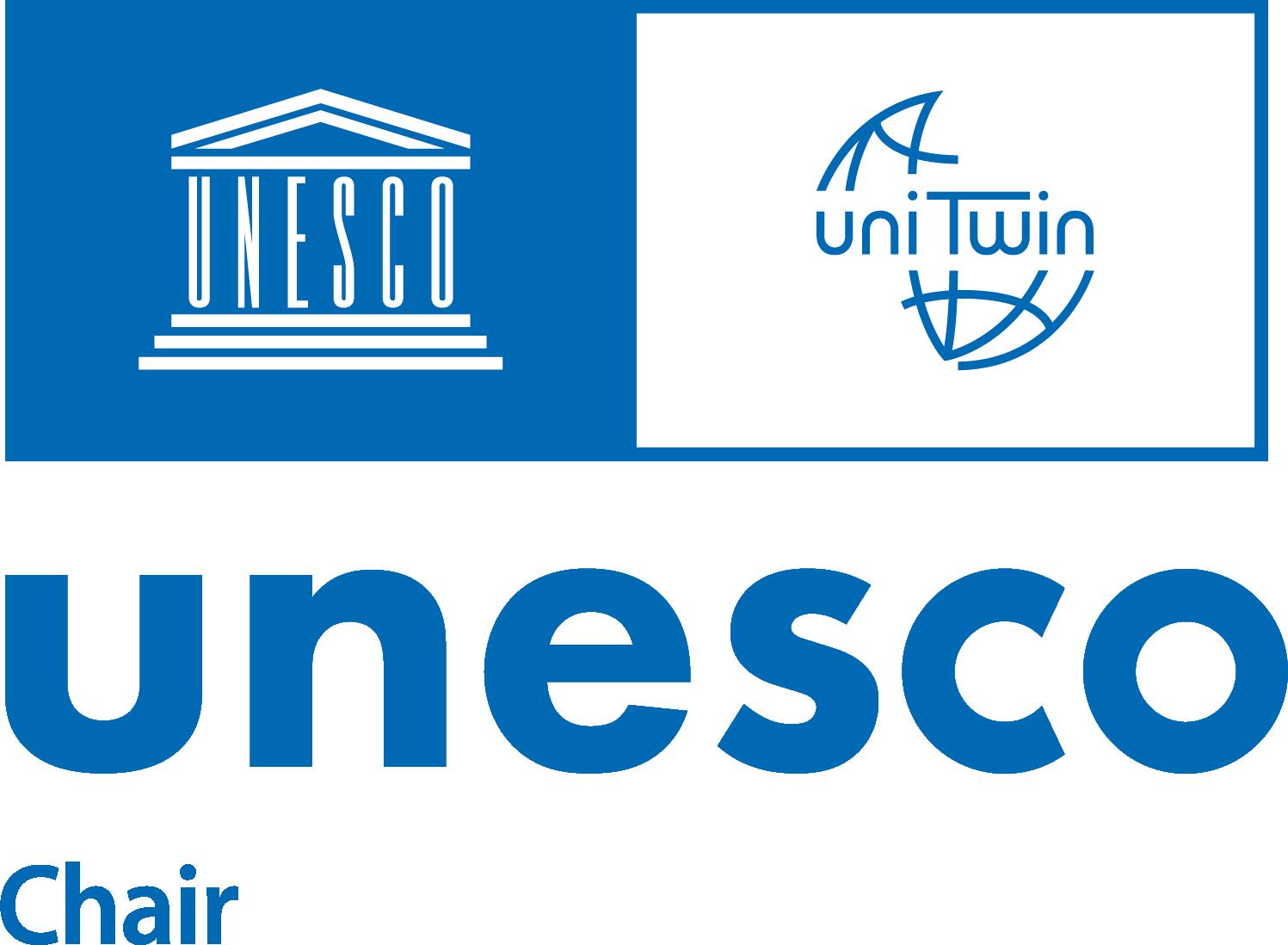


Kebangsaan Malaysia and HVP/Global Variome have established the Global Globin Network (GGN) which comprises scientists, researchers, and academicians from 32 countries working to combat thalassemia by applying recent developments in human genetics. GGN consists of researchers, scientists and medical specialists who are from high income countries (HIC) as well as LMIC. GGN is, therefore, an ideal platform for collaboration at an international level for sharing of knowledge, technical skills and capacity building for all the counties especially those where thalassaemia is most common. It is hoped that this programme will be able to bridge the gap of “genomic divide” between HIC and the LMIC.
The UNESCO Chair on Human Genetics of Thalassaemia was awarded to Universiti Sains Malaysia (USM) in November 2022. This is the first chair on human genetics awarded by UNESCO. It will focus on human genetics with a particular reference to Thalassemia, which is one of the commonest genetic diseases globally. This project will be led by Prof. Zilfalil Alwi from Human Genome Centre, USM. A key objective of the UNESCO Chair on human genetics of thalassaemia is to promote knowledge and capacity building in human genetics among low- and middleincome countries (LMIC) by taking thalassaemia as a model genetic disorder and, thereby, to contribute in reducing the genetic disease burden.
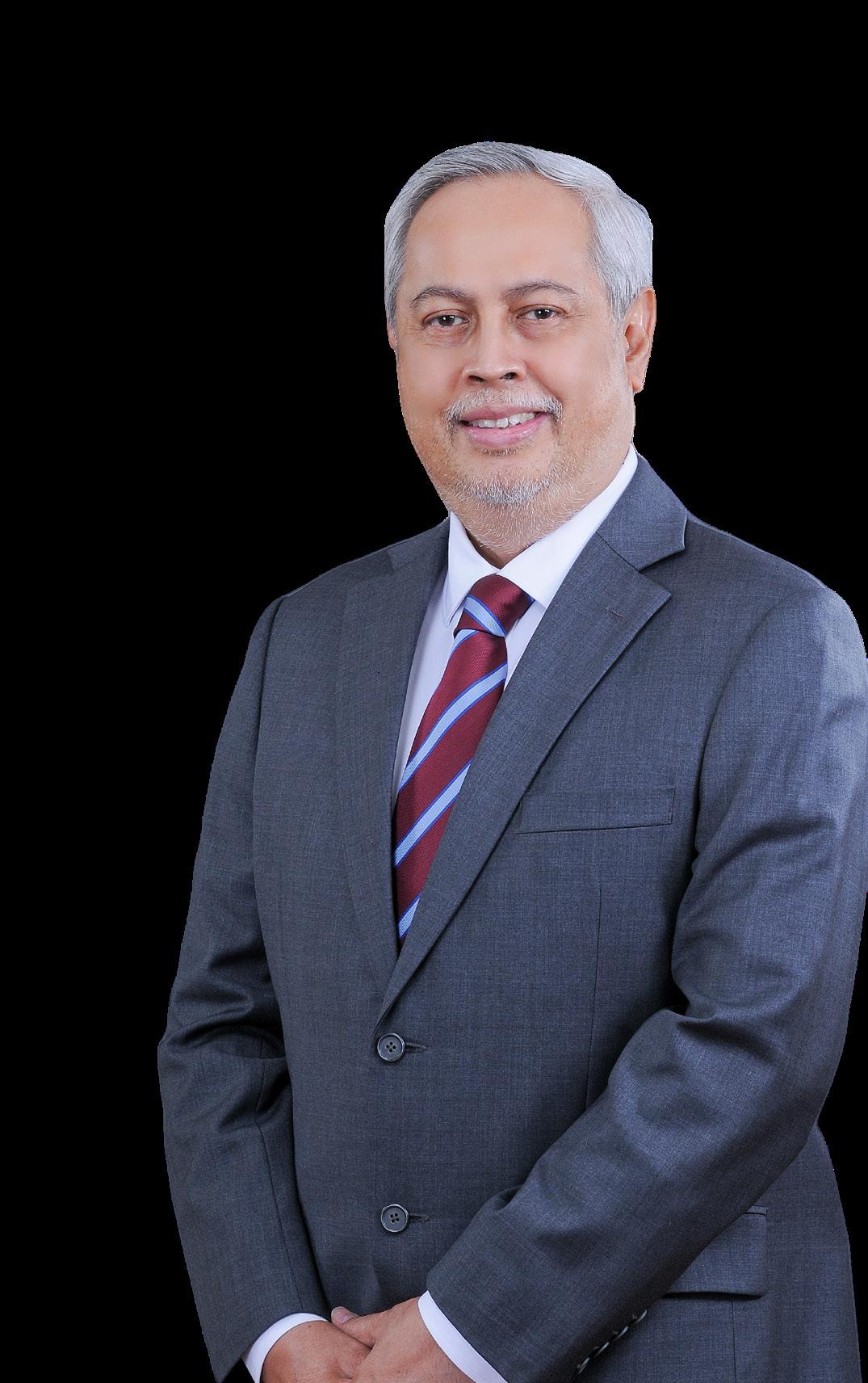
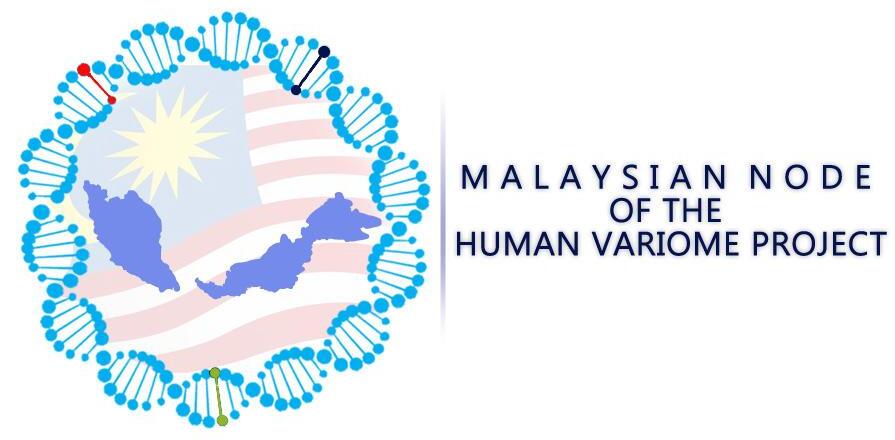
The establishment of this UNESCO Chair is closely related to the Human Variome Project (HVP) which started working with the UNESCO since 2011 and is recognised as an NGO official partner of UNESCO. Since then, this project has been expanded into the establishment of two project-wide initiatives to focus on a common disease in low- and middle-income countries (Thalassaemia) and another common disease in high-income countries (Breast cancer). In 2016, Universiti Sains Malaysia together with Universiti
The focus of this project is aligned to the context of World Health Organisation (WHO) Sustainable Development Goal (SDG) 3 in ensuring healthy lives and promotion of well-being for all at all ages.

Contact us: | Secretariat Office: Human Variome Project Malaysian Node & South-east Asian Node School of Medical Sciences, Universiti Sains Malaysia, Health Campus, 16150 Kubang Kerian, Kota Bharu, Kelantan, Malaysia | Phone :(60) 097676543 / 6531 | Fax: (60) 097676543 | Email : myhvp@usm.my | Website: hvpmalaysia.kk.usm.my NewsMyHVP letter Volume 07 | Issue 01 | June & December2022
Thalassaemia is one of the most common genetic diseases in low- and middleincome countries (LMIC). Without proper
Prof. Zilfalil Alwi Chairman, UNESCO Chair on Human Genetics of Thalassaemia
MyHVP Newsletter
Board of Editors 2022
ISSN: 2550-1747 | Volume 07 | Issue 01| June & December 2022
Editor in Chief
Professor Dr. Zilfalil Alwi

Managing Editor
Dr. Nik Norliza Nik Hassan
Editorial Board Members
Prof. Ida Madieha binti Azmi
Assoc. Prof. Dr. Muhammad Farid Johan
Assoc. Prof. Dr. Rosnah Bahar
Mr. Abdul Halim Fikri Bin Hashim
English Editor
Amyzar Alwi
Call for papers
© 2022. All rights reserved. The information in this newsletter is provided by the Malaysian Node of the Human Variome Project (MyHVP) members including South-east Asian Node (HVPSEA Node) for educational / information purpose only. It is not a substitute for professional medical care and medical advice. The contents express the opinions of the authors who alone are responsible for their view expressed. MyHVP does not accept any legal responsibility for their contents.
Writers, Invited!
MyHVP Newsletter is issued biannually. For the coming issue, the public from various fields and specialties are invited to their lived experience in dealing with the issues of medicine or biomedicine. Writers can contribute their writing based on these following criteria:
1. Length (Max. 1page A4 size, and it may be edited for our use)
2. The committee has the right to share your writing for further issues.
3. To suit the needs of the publication, and your writing won’t be returned
4. Emailed the article to myhvp@usm.my
Published by Malaysian Node of the Human Variome Project (MyHVP) School of Medical Sciences
Universiti Sains Malaysia Health Campus
16150, Kubang Kerian, Kelantan, Malaysia
Tel: +6097676531 /6543 | Email: myhvp@usm.my
In November 2022, Universiti Sains Malaysia was awarded the UNESCO Chair on Human Genetics of Thalassaemia, marking the inaugural chair on human genetics awarded by UNESCO. The establishment of this UNESCO Chair is closely associated to the Human Variome Project (HVP), which has been an official NGO partner of UNESCO since 2011. To date, the project has expanded to include two initiatives focused on common diseases in low- and middle-income countries (LMIC) (Thalassaemia) and another common disease in high-income countries (Breast cancer).
The UNESCO Chair on Human Genetics of Thalassemia is a 4-year project chaired by me. The main activities of this program are online teaching and advocacy programs aimed at promoting knowledge and capacity building in human genetics among LMIC by taking thalassaemia as a model genetic disorder and, thereby, contribute to reducing the genetic disease burden. It is estimated that this program will benefit about 12 countries of LMIC in Asia.
This year, MyHVP has been awarded the “KPT Prihatin, Komuniti Sejahtera (KRIS)” grant to implement the EduVariome program. This program is an awareness-raising platform to educate the public, especially secondary school form 4 students, on the burden of thalassaemia disease. The program will involve 30 secondary schools in 8 Kelantan districts with more than 1000 students as participants. We hope that this program will encourage other institutions and organizations to conduct and participate in
these activities to improve healthcare and raise awareness of inherited diseases in our country.
We are pleased to inform all the MyHVP members of the successful publication of the June 2022 issue of our journal, the Malaysian Journal of Human Genetics (MJHG). Meanwhile, the December 2022 issue is in the process of publication. For the upcoming June 2023 issue, the Editorial Board seeks submission of more articles from MyHVP members. Your continuous contribution and support are pivotal to the success of our journal publication.
If you have articles of interest to contribute to this newsletter, please contact us with any news, announcements, or views in your field of study by emailing it to me at zilfalil@gmail.com or to any members of the editorial board.
Thank you.
Prof. Dr. Zilfalil Alwi Head, Malaysian Node of the Human Variome Project (MyHVP)
MyHVP Newsletter | June & December 2022 | page 2
2 Board of Editors 2022 3 Report
Article
Obituary 10
4-7
8-9
Head’s Address
Contents
EDUVARIOME: Educating People Towards a Healthier Nation
EduVariome is a knowledge-sharing program with the community that utilises forum as a medium to raise an awareness of and provide early exposure to high school students about the importance of premarital genetic screening for thalassemia disease.
MyHVP has succesfully obtained a grant with the amount of RM49,829.00 from the Ministry of Higher Education Malaysia to organise EduVariome Program. Between September and December 2022, we successfully organized two EduVariome programs at Sek. Men. Keb. Chetok, Pasir Mas and Sek. Men. Long Yunus, Bachok, Kelantan. A total of 280 fourth-year students from these two districts were selected for the program. The following is the list of schools involved:
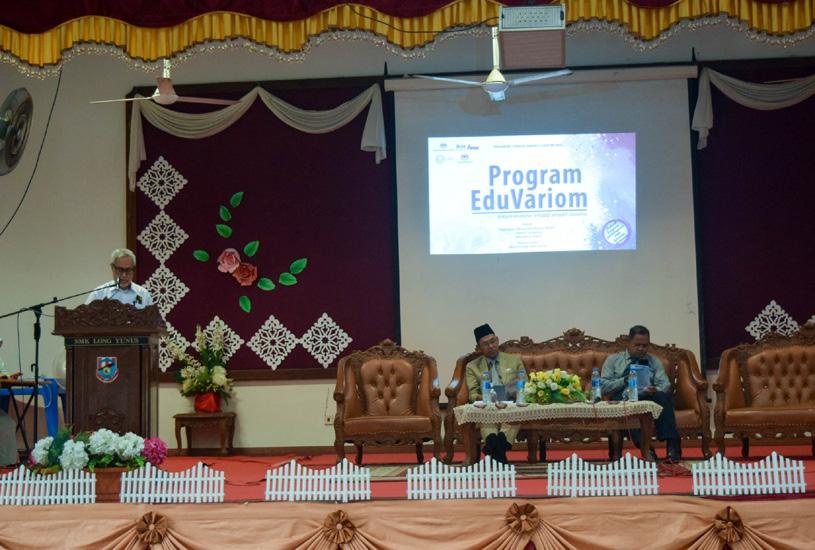

Pasir Mas:
SMK Chetok (host)
SMK Kangkong
SMK Tengku Panglima Raja

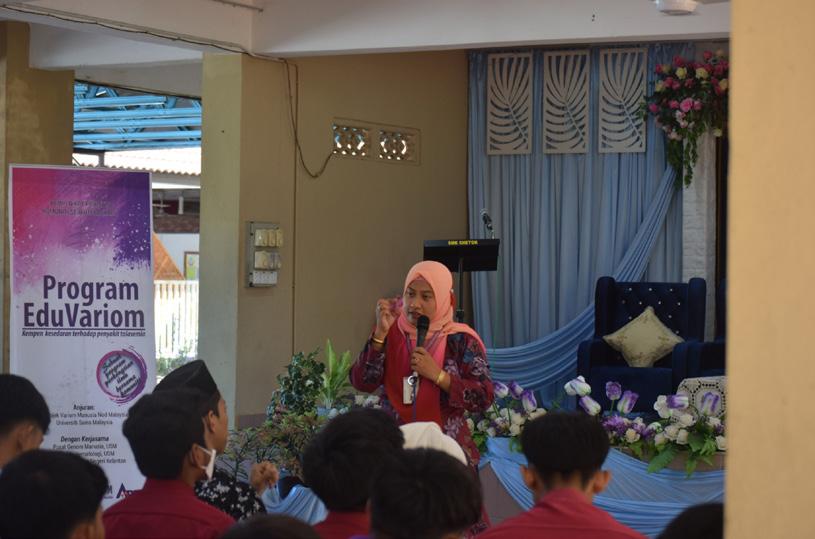
SMK To’Uban
SMK Sultan Ibrahim 1
Bachok:
SMK Long Yunus (Host)
SMK Sri Nipah
SMK Badak
SMK Dato’ Perdana
SMK Bachok
The implementation of this program was driven by the increasing rate of thalassemia cases among the Malaysian
population each year, with a high awareness rate of thalassemia, which is 1:20 Malaysians. This situation requires the cooperation of all parties to reduce thalassemia cases in the future generations.
The program started with the administration of a preprogram survey questionnaire to the students to test their understanding of thalassemia. This was followed by a forum that was moderated by Dr. Nik Norliza Nik Hassan and three panels. The interaction session with the students then started with a quiz, and students who successfully answered the questions were each presented with a token of appreciation. Before the program ended, a post-program survey questionnaires were administered to the students to measure whether the expected improved understanding of thalassemia took place in the participants in the program.
MyHVP Newsletter | June & December 2022 | page 3 Report
EduVariome at SMK Long Yunus, Bachok, Kelantan
EduVariome at SMK Chetok, Pasir Mas, Kelantan
| Continued from page 1,
treatment, a thalassaemia patient faces many complications which might cause mortality. Patients include children with severe thalassaemia who are prone to significant physical, psychological and social distress. This is because thalassaemia is characterized by decreased haemoglobin production, either affecting the alpha or beta chain. At a certain level, thalassaemia will lead to severe anaemia that requires blood transfusion to sustain life.
This programme is aimed at encouraging collaboration amongst students, scientists, clinicians and researchers in related fields of human genetics in the LMIC thereby pooling and enhancing skills and knowledge in innovative science that could lead to new discoveries. In short, collaborate to embrace the new. These activities can be implemented via collaborative expertise such as online teaching with graduate students from selected LMIC, seminars and workshops on genetics lab, visiting professorships and institutional development. Other activities such as advocacy will also be included in this program via EduVariome programme with the aim of creating awareness on the burden of genetic disease including thalassaemia.
In conjunction with the award of UNECO Chair, an inaugural lecture will be delivered on 6th February by Prof. Zilfalil Alwi. This lecture aims to introduce to the public the UNESCO Chair and highlight its contribution to the nation and the world.

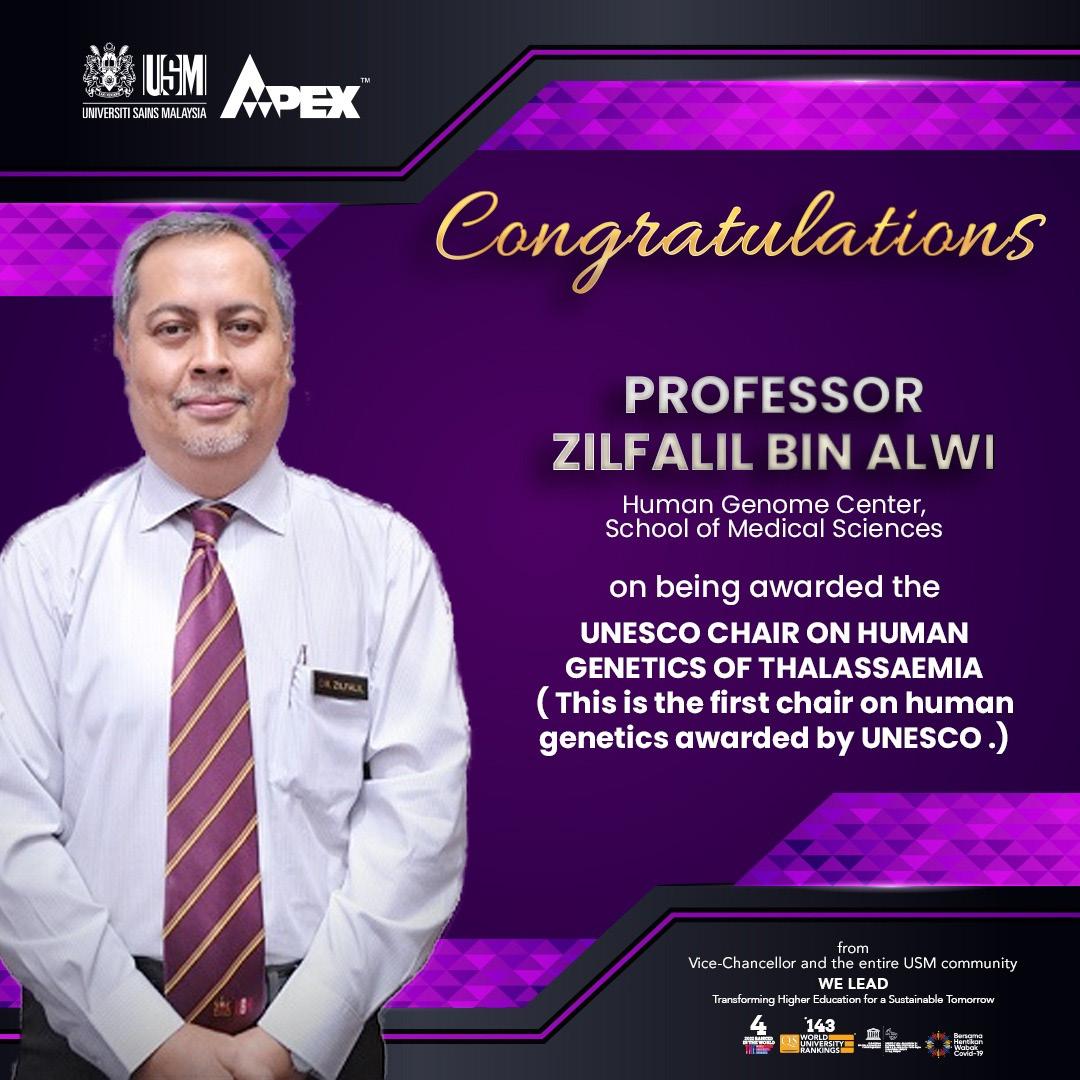
MyHVP Newsletter | June & December 2022 | page 4 Article
Canker sores: Types and management
Dr. Rabiatul Basria S. M. N. Mydin1*, Alif Haikal Bin Elias1,2 and Anis Farhan Kamaruddin3
1 Oncological and Radiological Sciences Cluster, Advanced Medical and Dental Institute, Universiti Sains Malaysia, 13200 Kepala Batas, Pulau Pinang, Malaysia.
2 Department of Science Biology, Faculty of applied science, Universiti Technologi of MARA, Kampus Arau, 02600 Arau, Perlis, Malaysia.
3 Craniofacial & Biomaterial Sciences Cluster, Advanced Medical & Dental Institute, Universiti Sains Malaysia, 13200 Kepala Batas, Penang, Malaysia
* Corresponding Author: Dr Rabiatul Basria S. M. N. Mydin (PhD); Email: rabiatulbasria@usm.my; Tel: +604-5622351
only a week or two. However, they can indicate oral cancer or virus infection in some situations, such as herpes simplex (Lewis & Wilson, 2021).
Are canker sores cancerous?
Canker sores have distinct symptoms. New or persistent ulcers, on the other hand, must be examined. Canker sores are frequently painful, but mouth cancer is not. Canker sores heal in approximately two weeks, whereas mouth cancer does not heal and frequently spreads. Mouth cancer patches can be harsh, hard, and difficult to remove (Aphthous Mouth Ulcers, 2020). Mouth cancer is frequently characterized by a mix of red and white regions or huge white areas on the tongue, back of the mouth, gums, or cheeks. Mouth cancer is usually linked to alcohol consumption or cigarette usage (Mittal and Nautiyal, 2019). Mouth ulcers can affect anyone. However, if the condition worsens, professional healthcare should be contacted.
Canker sores
Canker sores, also known as aphthous ulcers, are tiny, painful lesions that form in the mouth or at the base of the gums. They can make eating, drinking, and conversing difficult. Women, adolescents, and persons with a family history of canker sores are more likely to develop them. Ulcers in the mouth are not contagious and usually heal in one to two weeks (Aphthous Mouth Ulcers, 2020). However, a dentist should be consulted if a canker sore becomes large or painful or does not cure after a long time (Mittal and Nautiyal, 2019).
Figure 1. Canker sores appear as small, painful swellings on the lips or inside the mouth (Hill, 2021). As depicted in Figure 1, these sores can occur on the lips, tongue, cheeks, gums, floor, and roof of the mouth, among other soft tissues.
The canker sore is a common illness that many people experience at some point in their lives. The canker sores can even develop on the oesophagus and the tube leading to the stomach (Aphthous Mouth Ulcers, 2020). Canker sores, for example, are usually a minor nuisance that lasts
Figure 2. Situation when a doctor’s appointment is required. An appointment with a dentist is needed when a condition such as Canker sores are massive, an ulcer that extends from the mouth to the lips, and pain that lasts longer than three weeks. These situations are usually not common when typical or minor canker sores occur. High body temperature because of the canker sores and a new ulcer that forms before the old one heals also needs to be checked out by the dentist.
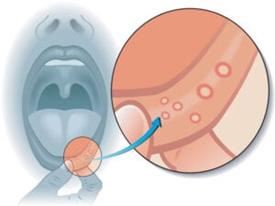
Types of canker sores
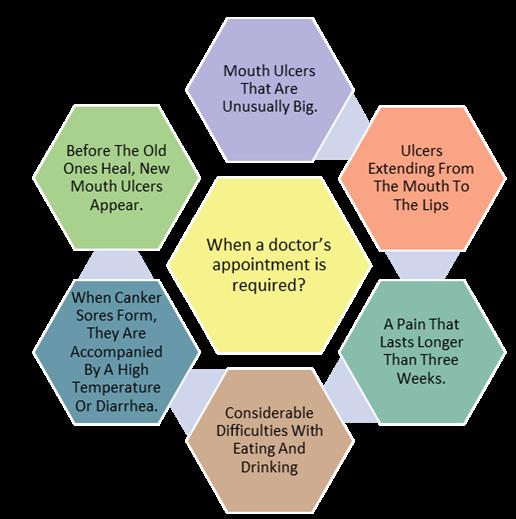
There are three types of canker sores: minor, major, and herpetiform.
1) Minor
Minor canker sores are tiny, oval or circular ulcers that heal without scarring. This type is the most prevalent. This type might be as small as 2 millimetres (mm) or as large as 8 mm wide. These ulcers typically take up to two weeks to
MyHVP Newsletter | June & December 2022| page 5 Article
heal and cause minimal pain. They are tiny ulcers with a diameter of less than 5 mm that can occur singularly or in clusters. They usually do not cause discomfort and pain (Mittal and Nautiyal, 2019).
2) Major
Major ulcers are larger than minor ulcers, have an uneven shape, may be elevated, and penetrate deeper into the tissue than minor ulcers. As a result, they can take many weeks to clear and will most likely leave long-term scar tissue when they do. In addition, they might take up to six weeks to heal. These are rarer, measuring 5 mm or more, and can appear singly or in pairs (Aphthous Mouth Ulcers, 2020). They can be excruciatingly painful, especially when eating or drinking and can last from two weeks to several months (Lewis & Wilson, 2021).
3) Herpetiform
Adults are frequently affected with herpetiform canker sores, pinpoint in size and appear in clusters of 10 to 100. This form of canker sores has uneven edges and heals in one to two weeks without scarring. However, when many tiny lesions fuse to form massive, irregularly shaped ulcers, this can happen (Mittal and Nautiyal, 2019). Herpetiform ulcers are named from their appearance, similar to those of herpes. However, herpetiform ulcers are not caused by the herpes simplex virus (Lewis & Wilson, 2021).
Possible causes of canker sores

The specific cause of canker sores is unknown, and it differs from one person to the next. Ulcers can occur due to a particular medical disease or a dietary deficiency in some persons. In addition, ulcers can be caused by various factors, including celiac or Crohn’s disease, vitamin B12 or iron deficiencies (Aphthous Mouth Ulcers, 2020). Figure 3 shows a few principal reasons and conditions that aggravate canker sores.
infection might cause. Infections can be caused by an overpopulation of naturally occurring organisms in the mouth or by newly introduced species, such as the bacteria that cause gonorrhoea or syphilis. In addition, bacterial infections of the teeth or gums can create a pus-filled pocket of infection (abscess) or widespread inflammation (cellulitis) (Hennessy, 2021).
During the early stages of infection, syphilis may cause a red, painless sore (also known as a chancre) to appear on the lips or inside the mouth. The ache heals typically in a few weeks. However, if the syphilis is not treated, a white spot (mucous patch) may grow on the lip or inside the mouth 4 to 10 weeks later. The chancre and the mucous patch are highly infectious (Hennessy, 2021).
Candida albicans is a natural mouth flora. However, it can also overgrow in persons who have taken antibiotics or corticosteroids or who have a weakened immune system, such as AIDS patients. Candida can develop whitish, cheese-like patches that, when wiped away, erode the top layer of the mouth lining (thrush). At times, flat, red patches show (Hennessy, 2021). Klebsiella pneumoniae, Acinetobacter baumanii, Staphylococcus aureus, and Pseudomonas aeruginosa are the primary cause of canker sores (Anitha et al., 2016).
Management and treatment of canker sores
Pain and suffering from canker sores usually lessen in a few days and eventually disappear in about two weeks, with no need for therapy or medicine. However, a dentist may prescribe a treatment to minimize swelling and pain in those with more painful or frequent recurrences of canker sores. A dentist may also recommend an antimicrobial mouthwash or ointment that should be put directly to the wounded area. This treatment may assist in reducing discomfort. In addition, there are a variety of canker sores treatments accessible for online purchase (Lewis & Wilson, 2021).
Figure 3. Causes of canker sores. Canker sores can occur because of biting the inside of the cheek or the tongue, dental products that can irritate the mouth and gums, and hereditary influences can cause canker sores, as shown in figure 3. Besides that, citrus and other spicy food can cause mouth ulcers as they cause high acidity and are more likely to distress the skin.
Microbe’s related to canker sores
There are sores and swelling in the mouth that a bacterial
Doctors prescribe antibiotics to persons who have bacterial infections. It is essential to avoid any chemicals or drugs that produce canker sores. Frequently, gentle tooth brushing with a soft brush and salt-water rinses may aid in the prevention of sores becoming infected (Hennessy, 2021). Pharmacists should prescribe an antiseptic or a topical anti-inflammatory spray. If the person appears to be in excellent condition, symptomatic treatments with a warm saline mouthwash, topical chlorhexidine, or benzydamine spray may help (Hill, 2021). Patients are encouraged to see a dentist to remove any dental sources of trauma (Aphthous Mouth Ulcers, 2020). Aluminum-magnesium antacids and sucralfate-based protective coatings might be soothing when used as a rinse. However, many doctors include other chemicals like lidocaine and/or diphenhydramine (an antihistamine). Another option is amlexanox paste. Mouth rinses containing alcohol (ethanol) should be avoided because they may aggravate canker sores (Hill, 2021). After therapy, the oral epithelium should recover in a few days. If the ulcer lasts longer than three weeks, people should see their dentist to rule out the possibility of cancer (Lewis & Wilson, 2021).
MyHVP Newsletter | June & December 2022 | page 6 Article
Conclusion
Canker sores are rarely a cause for concern. They are relatively prevalent, with a variety of causes and triggers. Individuals who recognize their triggers may find it easier to avoid ulcer formation. There are many possible causes of canker sores that can be a concern and avoided. Microbes related to canker sores can cause severe or minor ulcers. Therefore, early diagnosis and treatment should be the precedence. Home remedies can help alleviate symptoms and hasten the healing process. The treatment and management of canker sores are relatively easy as they can be treated with a medication bought at the pharmacy. Anyone experiencing persistent sores that do not heal or sores that reoccur regularly should consult a doctor for a diagnosis and treatment.
Acknowledgement
The authors would like to thank Universiti Sains Malaysia for sponsoring this work under the research university grant RUI EKSESAIS 2019 (No:1001/CIPPT8012338).
References
1. Anitha, M., Monisha, D., Ramya, K., Chinmayee, Y., & Mohamed Sulthan, A. (2016). A study on the occurrence of bacterial isolation in mouth ulcer patients. International Journal Of Advanced Research In Biological Sciences (IJARBS), 3(10), 188-192. doi: 10.22192/ ijarbs.2016.03.10.025
2. Ada’s Medical Knowledge Team. (2020, February 14). Aphthous Mouth Ulcers. Ada. Retrieved November 22, 2021, from https://ada.com/conditions/aphthous-ulcers/.
3. Hennessy, B. (2021). Mouth Sores and Inflammation - Mouth and Dental Disorders - MSD Manual Consumer Version. Retrieved 30 November 2021, from https://www.msdmanuals.com/home/mouth-and-dentaldisorders/symptoms-of-oral-and-dental-disorders/mouthsores-and-inflammation
4. Hill, A. (2021). Canker Sores (Causes & How to Get Rid of Them Quickly). Retrieved 30 November 2021, from https://www.newmouth.com/oral-health/canker-sores/
5. Lewis M. & Wilson N. (2021, April 22). Oral ulceration: Causes and management. The Pharmaceutical Journal. Retrieved November 25, 2021, from https:// pharmaceutical-journal.com/article/ld/oral-ulcerationcauses-and-management.
6. Mittal, S., & Nautiyal, U. (2019). A review: herbal remedies used for the treatment of mouth ulcer. International Journal of Health and Clinical Research, 2(1), 17-23.
MyHVP Newsletter | June & December 2022| page 7 Article
Obituary
Prof. Zarina Abdul Latiff
Prof Dr Zarina Abdul Latiff, a Senior Consultant Paediatrician & Clinical Geneticist at Universiti Kebangsaan Malaysia Medical Centre (UKMMC) passed away on 15 October 2022 at the age of 55 at UKMMC in Kuala Lumpur, after battling cancer for more than 6 years. With her demise Malaysia not only lost the pioneer in the fields of Clinical Genetics and Genetic Counselling but also an outstanding Paediatric Hemato-oncology.
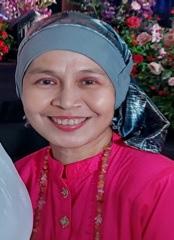
Prof Dr Zarina Abdul Latiff started her career as a medical doctor upon graduating from University of Malaya in 1992 and subsequently obtained her Master of Medicine (MMed) in Paediatrics from UKM in 1998. She then pursued her postgraduate sub-specialty training in medical genetics at the University of Glasgow and University of Southampton in the United Kingdom. Upon her return to Malaysia, she continued to serve as a senior lecturer at UKMMC. She was later promoted to Associate Professor and then Professor at the Department of Paediatrics. In 2011, she was appointed as the Head of the Department of Paediatrics followed by the appointment as Deputy Dean of postgraduate studies of UKMMC. She was also the Head of the Thalassaemia Centre at UKMMC and a committee member for the development of UKM Children Specialist Hospital.
As a health advocate for women and children, Prof Dr Zarina was active in community service and in various professional organizations and NGOs. She was the co-chair for the Health Committee of National Council of Women’s Organisations Malaysia (NCWO). She was also a committee member of the Clinical Management and Support of Rare Disease as well as, an executive committee member for the Global Globin Network and a member of the Education Committee for Human Genome Organisation (HUGO). In 2020, she was conferred Darjah Setia Negeri Sembilan (D.N.S) by the state ruler DYMM Yang di-Pertuan Besar Negeri Sembilan Darul Khusus, Tuanku Muhriz Ibni Almarhum Tuanku Munawi as a recognition of her professional and civic contributions.
Prof. Dr. Zarina will always be remembered for her sincerity, kindness, dedication, dilegence, and patience in dealing with work and life. Her fiery spirit and positive outlook in life has made her an exemplar professional well-respected by all.
Prof. Dr. Zarina is survived by her daughter, relatives, students, patients, colleagues, and friends who mourn her death. May Allah grant her the eternal abode in Heaven and grant her family fortitude and sabr in this difficult time.
Al-fatihah.
Written by, Prof Zilfalil bin Alwi Universiti Sains Malaysia
MyHVP Newsletter | June & December 2022 | page 8
Prof. Dr. Amir Feisal Merican Bin Aljunid Merican
Prof. Dr. Amir Feisal Merican, a professor at Institute of Biological Sciences, faculty of Science, University of Malaya passed away on 17th December 2022 at the age of 54 at Universiti Malaya Medical Centre (UMMC) in Kuala Lumpur due to lung infection.With his demise, Malaysia lost a renowned bioinformatician, scientist, geneticist and scholar.
Prof Amir Feisal obtained a first class honours degree in Microbiology from the University of Malaya (UM) in 1992. He was appointed a lecturer in UM in 1995 after successfully completing his DPhil in Biochemistry and Molecular Microbiology at the University of Oxford, England. In 2006, he was awarded a MPhil degree in Computational Biology from the University of Cambridge, England. He spearheaded the development of the curriculum for both the Bachelor of Science (Bioinformatics) and Master in Bioinformatics (by coursework) degree programmes, both the first in Malaysia.
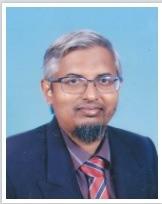
Prof Amir Feisal served as the director of the Centre for Computational and Systems Biology at the Malaysia Genome Institute of the Ministry of Science, Technology and Innovation (MOSTI) from November 2009 to November 2011. He was also one of the co-founders and the ex-President of the Malaysian Society of Bioinformatics and Computational Biology (MaSBiC). Prof Amir Feisal founded and headed the Centre of Research in Computational Sciences and Informatics for Biology, Bioindustry, Environment, Agriculture and Healthcare (CRYSTAL), a University of Malaya research centre.
For all his contributions, Prof Amir Feisal received many distinguished awards, which include Japanese Bioindustry Association for research in Molecular Systematics with Professor Takayuki Ezaki at Gifu University School of Medicine, Japan (1998), Fulbright Fellowship for research in Bioinformatics with Nobel Laureate Professor Walter Gilbert at Harvard University (2000), Commonwealth Fellowship for research in Molecular Microbial Ecology with Professor Jon Saunders at Liverpool University (2001) and Excellent Service Award, University of Malaya (2003).
Prof Amir will always be remembered as a dedicated, efficient, determined and well-read scholar who strived for excellence. He had an uncanny ability to reach people in a deep and positive way with his kindness, humility, consideration, generosity, affection, and thoughtfulness. His wisdom and exceptional achievements has made him a role model and an icon for his students, young researchers and colleagues. To this, we give thanks for the life and career of Prof Amir.
Prof. Dr. Amir Feisal Merican is survived by his wife, a son, four daughters, a daughter-in-law, a grandson, relatives, students, colleagues, and friends who mourn his death. May Allah grant him Jannatul-Firdaus and forgive his sins and may his grave be a place of comfort and light. May Allah grant his family fortitude and sabr in this difficult time.
Al-fatihah.
Written by, Prof Zilfalil bin Alwi Universiti Sains Malaysia
MyHVP Newsletter | June & December 2022| page 9 Obituary
Malaysian Journal of Human Genetics
The Malaysian Journal of Human Genetics (MJHG) (eISSN: 2716-649X) is the official journal of Malaysian Node of the Human Variome Project and Malaysian Society of Human Genetics. The MJHG publishes high quality peer reviewed original research, case report, short report and review articles that covers all aspect of human genetics including molecular, clinical, pharmacogenetics, population genetics and functional genomics. MJHG is now indexed in MyJurnal and Google Scholar.
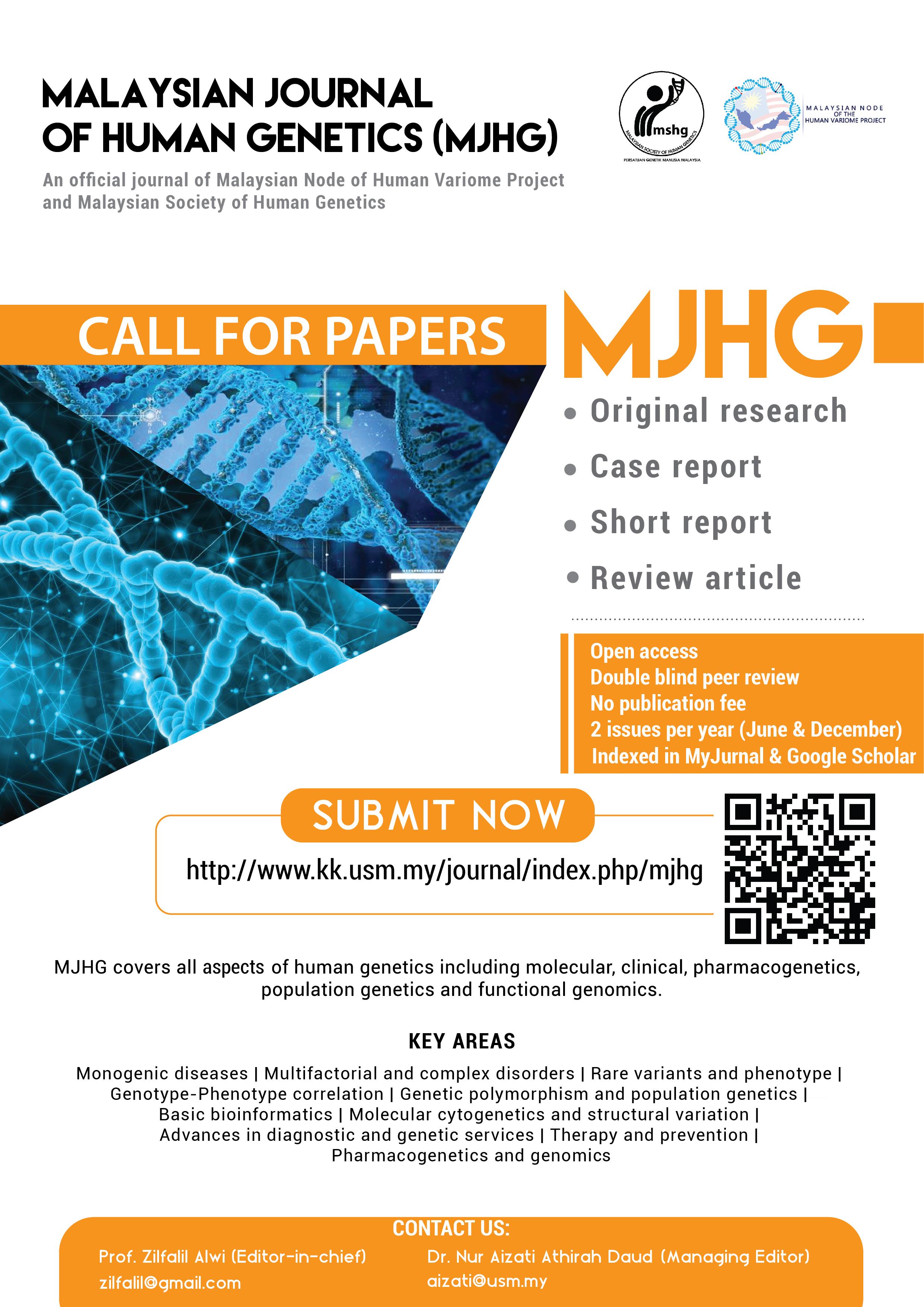
MyHVP Newsletter | June & December 2022 | page 10 Journal | Call
papers
for



















